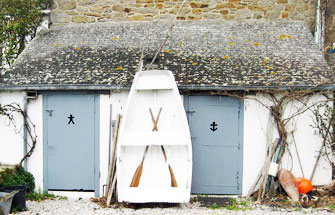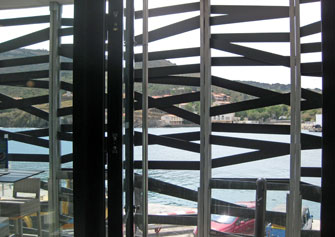
France is a land of many mysteries. Some, like the identity of the Man in the Iron Mask, have been a source of fascination to historians for centuries. Others have been a source of fascination only to me for about 10 minutes. Like, for example: who exactly is supposed to use the “anchor” toilet in Saint Suliac? And how are we supposed to know?
Fortunately, some questions are not meant to be answered. But, as in previous installments of this recurring feature, I like to answer them anyway. Let’s start with an easy one…
The question:

What’s up with this French brand name?
The answer:
Despite the fact that it’s a very simple, perfectly understandable linguistic coincidence, this kills me. In French, “grand” simply means “big,” possibly, as in this case, also implying “important and illustrious.” And “jury” means “panel of judges” — for a contest, not a felony hearing.
So to a French person, calling a garlic cheese spread “Grand Jury” says, “This cheese has been specially selected by a large panel of expert judges.” But to an American it says, “This cheese probably smells so strong it’s a crime.”
And speaking of strength…

Photo from Google Streetview.
During a recent weekend in the country, I happened to spot this old-fashioned pump off the side of the road in La Poltière, a village not far from Mont Saint Michel.
The question:
Obviously, that’s where they dug the well, but why the extra elevation? Isn’t fetching water arduous enough without having to climb up on a narrow and patently unnecessary platform? Did they lose the pipe cutter?
The answer:
I think they built it that way to give the old-timers in the village something to carp about to their grandchildren: “When I was your age we didn’t even have plumbing! When we wanted water, we had to walk two miles through the snow to the nearest hand pump and then haul a heavy bucket up and down nine steep steps! And there weren’t any of your sissy, nanny-state handrails either!”
Speaking of scaling treacherous heights toting containers of fluids…
The question:
If you’re going to risk arrest and injury by clambering up to a narrow, flimsy ledge on the outside of a building in order to proclaim your identity to the world in the form of graffiti, shouldn’t you make your tag at least slightly legible?
The answer:

According to the unsung Miro who defaced this building on Rue du Château d’Eau, the answer is non. But of course, legibility is not necessarily a guarantee of comprehensibility…
The question:

In what zone de crépuscule is this a logical track numbering sequence?
The answer:
In that parallel universe called Moret Sur Loing. Readers who have memorized every article I’ve ever written already understand what I mean.
For the benefit of those who just haven’t gotten around to it yet, for some reason, Moret is a very nice little town just south of Paris where Nancy and I like to go for weekends once in a while. I once wrote about how getting there can be a real challenge. As I explained in that piece, the technique for traveling to Moret by train has a steep learning curve. It’s hard to find the right station in Paris, the right track in that station, the right place on that track to validate your ticket, and, for each of those steps, the right person to tell you the right information.
So it’s only fitting that you arrive at a station with three platforms, one of which is marked “4” and has two tracks, one labeled “B” and the other “2N.” Perfectly logical.
Unlike my transition here to the topic of maritime derring-do. Suddenly I’m writing about Robert Surcouf, an 18th-century privateer who gets mixed reviews depending on whose history books you read. He is remembered in France as a courageous, patriotic navigator who deserved a statue in his honor and in every other country whose ships crossed his path as an evil, thieving pirate who deserved a bullet in his ear.
As it worked out, he got the statue. It’s in a little park on the waterfront in Saint Malo and shows the legendary freebooter in an action pose with one arm gesturing northward toward the sea. But take a close look…

The question:
Is he pointing the way to wealth, glory and adventure on the high seas, or leading a round of “I’m a Little Teapot”?
The answer:
Neither. He’s actually pointing all the way around the world toward the next mystery on my list — across the English Channel, north through Britain, across the Norwegian and Greenland Seas, around the North Pole, across the tip of Siberia and the Pacific, skirting Hawaii, Fiji and New Zealand, traversing Antarctica, around the other pole, back up through the Atlantic and western Africa, then crossing the Mediterranean, eastern Spain and the Pyrenees and finally stopping at Port Vendres on the French Catalan coast, whose harbor looks like this:

Now then. The question:
If you were the owner of one of the best fish markets the author of this article has ever been to, on the bay in Port Vendres, with a little restaurant-bar upstairs serving superb, super-fresh seafood, would you want your customers to be able to enjoy the view?
The answer, in the form of another question:

Or would you randomly plaster the outside of the building with thick, dark slats, making all of your window seats about as well-lit and inviting as a table for two in the:

This is not the actual WC sign at the Port Vendres fish market, but it does mark what are very likely the next nearest public facilities, at the Paulilles Recreational Park just up the coast.
As readers who have been setting this article to music phrase by phrase are expecting, I have:
A question about this:
Why are all the figures decapitated and cut in half?
And an answer:
My theory is that the designer was, more or less subconsciously, evoking the history of the place. Paulilles is the former site of the Société Nobel Française — a dynamite factory, which suffered deadly explosions in 1877, 1882, 1934, 1936 and 1958. The symbols are just in keeping with the park’s heritage. A blast from the past, if you will.
Disconcerting, yes — but at least, unlike their counterparts in Saint Suliac, not to mention my explanations of all the other above-mentioned enigmas, these restroom icons are anchored in reality.
Have you seen something inexplicable in Paris, or anywhere in France? Send a photo (or at least a detailed description) to me in care of Paris Update, and I’ll try to explain “The Story Behind the Strangeness.”
© 2015 Paris Update
FavoriteAn album of David Jaggard’s comic compositions is now available for streaming on Spotify and Apple Music, for purchase (whole or track by track) on iTunes and Amazon, and on every other music downloading service in the known universe, under the title “Totally Unrelated.”
Note to readers: David Jaggard’s e-book Quorum of One: Satire 1998-2011 is available from Amazon as well as iTunes, iBookstore, Nook, Reader Store, Kobo, Copia and many other distributors.
